HI5016 - International Trade: Comparative Analysis of Industries
VerifiedAdded on 2023/03/31
|10
|853
|263
Report
AI Summary
This report provides an analysis of intra-industry and inter-industry trade, highlighting the key differences and implications of each. It explores intra-industry trade as the simultaneous import and export of products within a nation or industry, contrasting it with inter-industry trade, which involves the exchange of different types of goods between nations based on factor endowments. Case studies of Pakistan and the European Union are used to illustrate these concepts, examining Pakistan's trade relations within SAARC and the EU's specialization in manufacturing based on comparative advantage. The report concludes that intra-industry trade offers greater benefits through economies of scale compared to inter-industry trade's reliance on comparative advantages. Desklib provides access to similar reports and solved assignments for students.
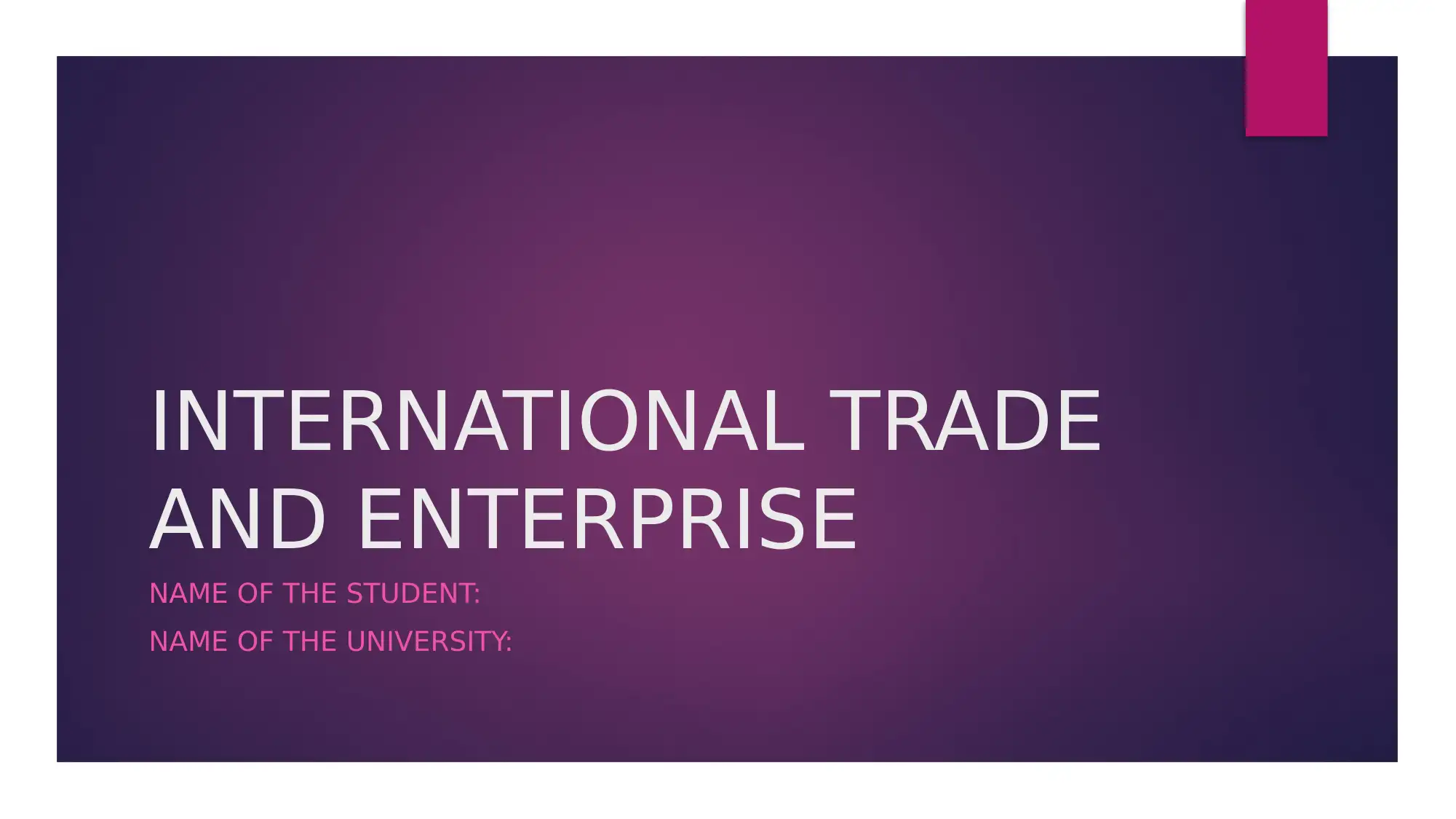
INTERNATIONAL TRADE
AND ENTERPRISE
NAME OF THE STUDENT:
NAME OF THE UNIVERSITY:
AND ENTERPRISE
NAME OF THE STUDENT:
NAME OF THE UNIVERSITY:
Paraphrase This Document
Need a fresh take? Get an instant paraphrase of this document with our AI Paraphraser
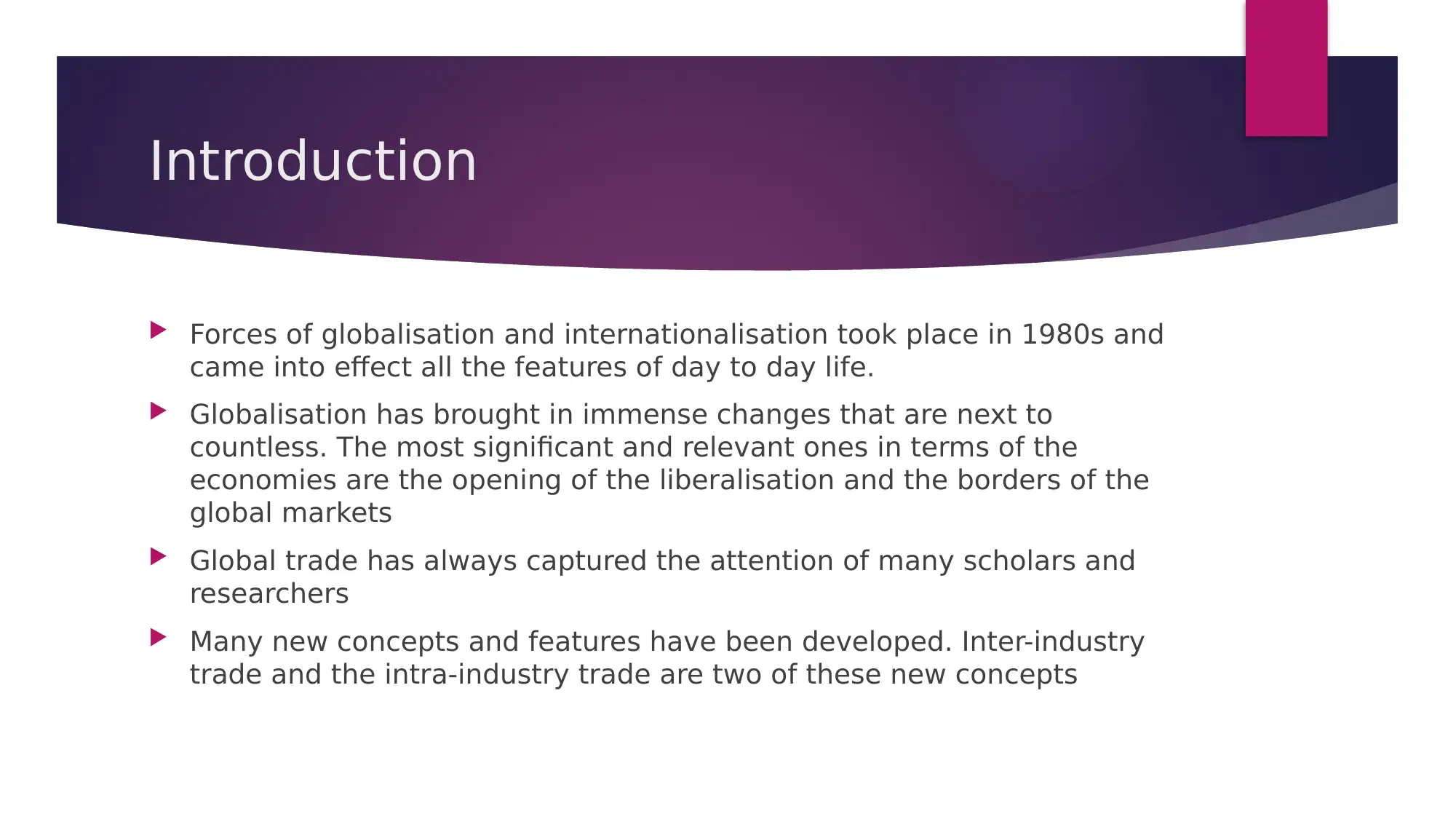
Introduction
Forces of globalisation and internationalisation took place in 1980s and
came into effect all the features of day to day life.
Globalisation has brought in immense changes that are next to
countless. The most significant and relevant ones in terms of the
economies are the opening of the liberalisation and the borders of the
global markets
Global trade has always captured the attention of many scholars and
researchers
Many new concepts and features have been developed. Inter-industry
trade and the intra-industry trade are two of these new concepts
Forces of globalisation and internationalisation took place in 1980s and
came into effect all the features of day to day life.
Globalisation has brought in immense changes that are next to
countless. The most significant and relevant ones in terms of the
economies are the opening of the liberalisation and the borders of the
global markets
Global trade has always captured the attention of many scholars and
researchers
Many new concepts and features have been developed. Inter-industry
trade and the intra-industry trade are two of these new concepts
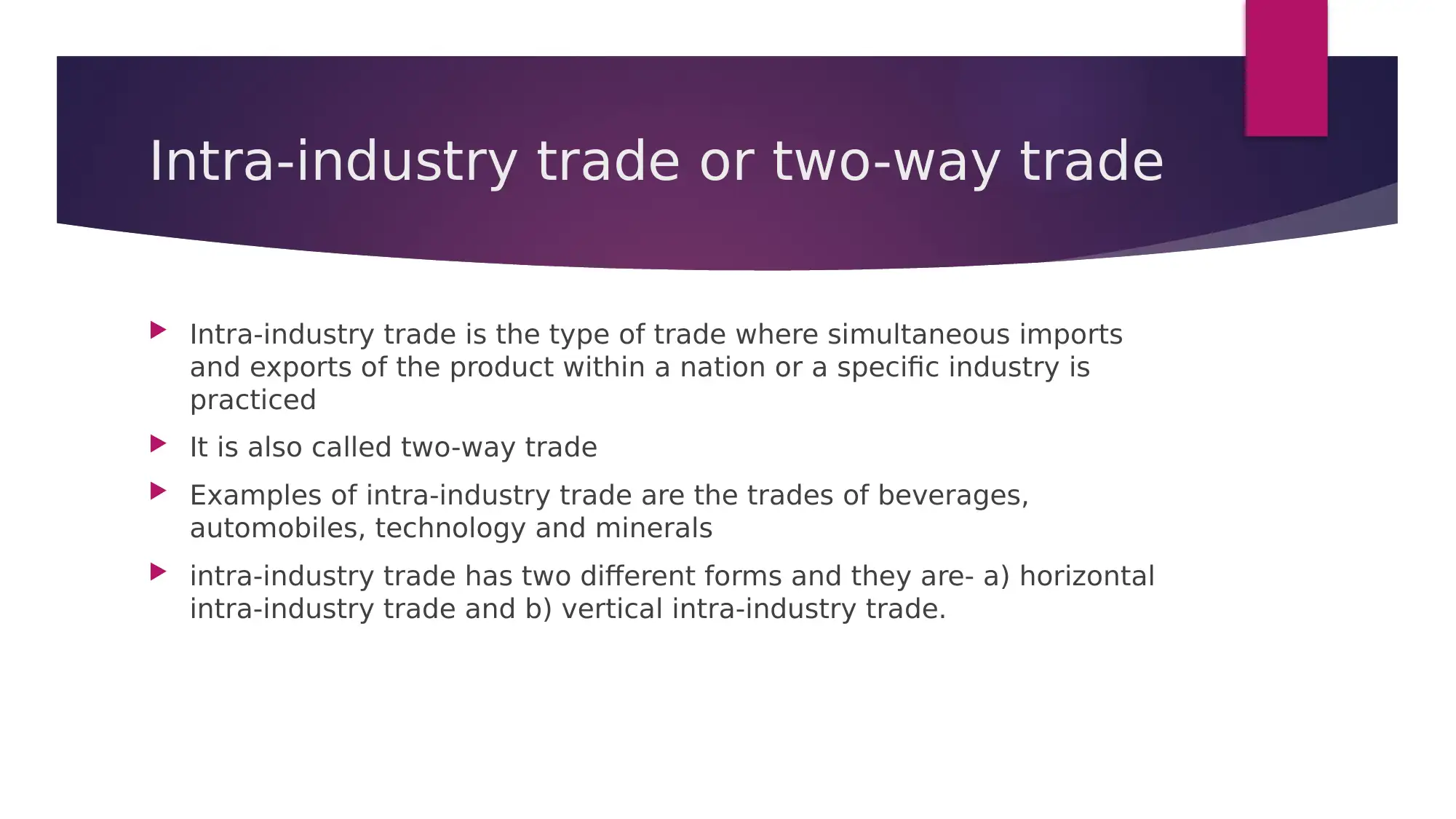
Intra-industry trade or two-way trade
Intra-industry trade is the type of trade where simultaneous imports
and exports of the product within a nation or a specific industry is
practiced
It is also called two-way trade
Examples of intra-industry trade are the trades of beverages,
automobiles, technology and minerals
intra-industry trade has two different forms and they are- a) horizontal
intra-industry trade and b) vertical intra-industry trade.
Intra-industry trade is the type of trade where simultaneous imports
and exports of the product within a nation or a specific industry is
practiced
It is also called two-way trade
Examples of intra-industry trade are the trades of beverages,
automobiles, technology and minerals
intra-industry trade has two different forms and they are- a) horizontal
intra-industry trade and b) vertical intra-industry trade.
⊘ This is a preview!⊘
Do you want full access?
Subscribe today to unlock all pages.

Trusted by 1+ million students worldwide
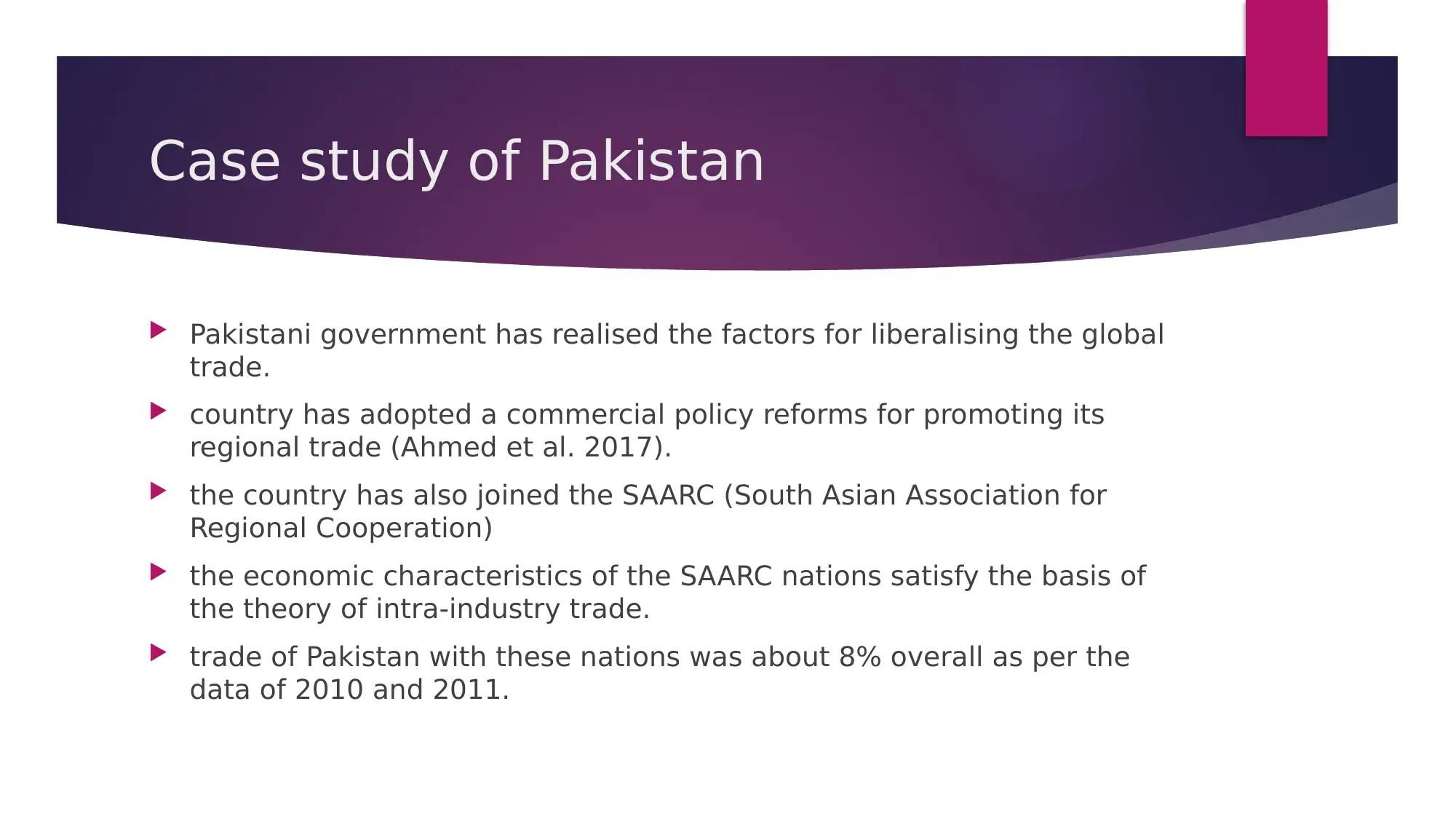
Case study of Pakistan
Pakistani government has realised the factors for liberalising the global
trade.
country has adopted a commercial policy reforms for promoting its
regional trade (Ahmed et al. 2017).
the country has also joined the SAARC (South Asian Association for
Regional Cooperation)
the economic characteristics of the SAARC nations satisfy the basis of
the theory of intra-industry trade.
trade of Pakistan with these nations was about 8% overall as per the
data of 2010 and 2011.
Pakistani government has realised the factors for liberalising the global
trade.
country has adopted a commercial policy reforms for promoting its
regional trade (Ahmed et al. 2017).
the country has also joined the SAARC (South Asian Association for
Regional Cooperation)
the economic characteristics of the SAARC nations satisfy the basis of
the theory of intra-industry trade.
trade of Pakistan with these nations was about 8% overall as per the
data of 2010 and 2011.
Paraphrase This Document
Need a fresh take? Get an instant paraphrase of this document with our AI Paraphraser
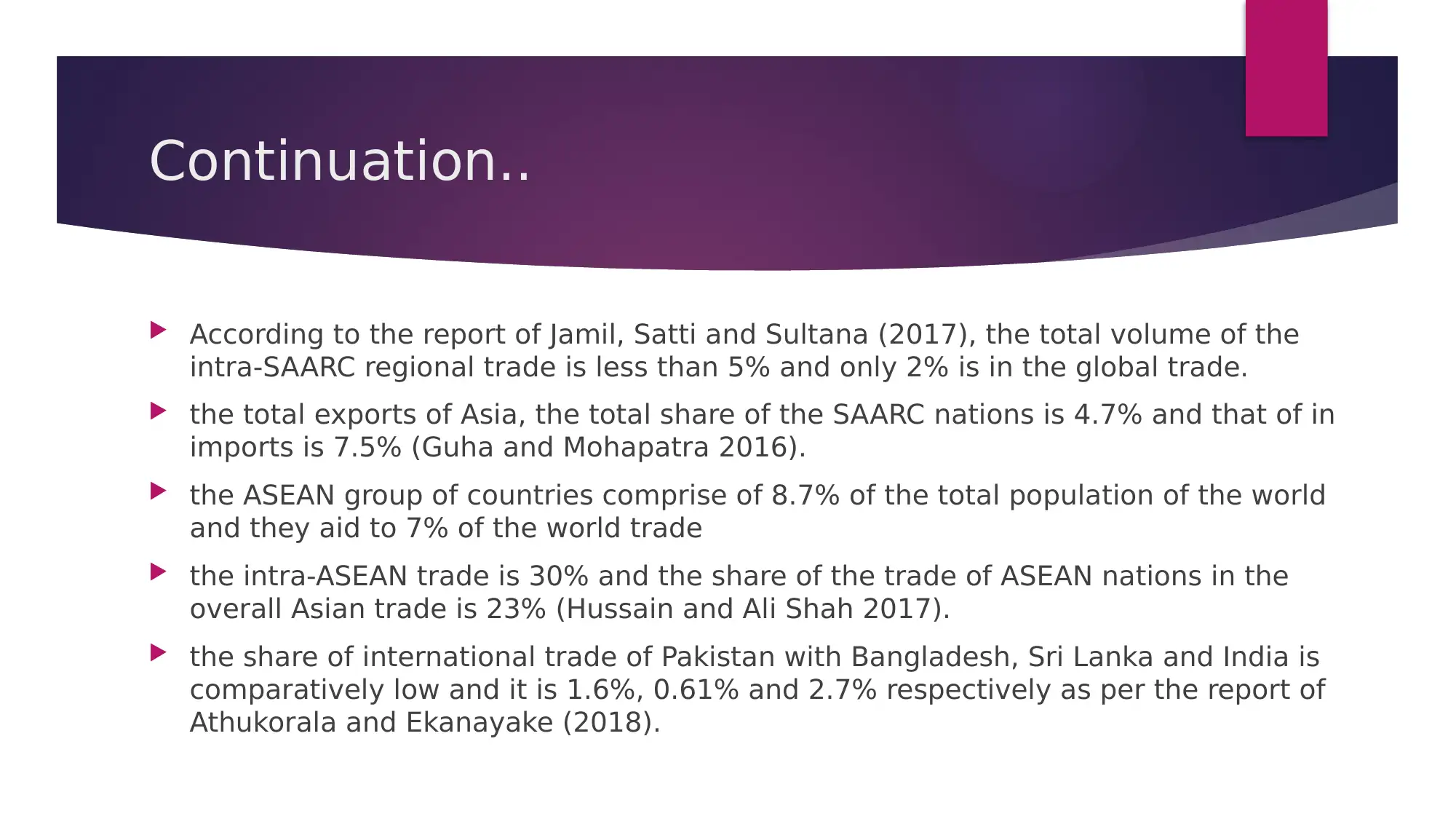
Continuation..
According to the report of Jamil, Satti and Sultana (2017), the total volume of the
intra-SAARC regional trade is less than 5% and only 2% is in the global trade.
the total exports of Asia, the total share of the SAARC nations is 4.7% and that of in
imports is 7.5% (Guha and Mohapatra 2016).
the ASEAN group of countries comprise of 8.7% of the total population of the world
and they aid to 7% of the world trade
the intra-ASEAN trade is 30% and the share of the trade of ASEAN nations in the
overall Asian trade is 23% (Hussain and Ali Shah 2017).
the share of international trade of Pakistan with Bangladesh, Sri Lanka and India is
comparatively low and it is 1.6%, 0.61% and 2.7% respectively as per the report of
Athukorala and Ekanayake (2018).
According to the report of Jamil, Satti and Sultana (2017), the total volume of the
intra-SAARC regional trade is less than 5% and only 2% is in the global trade.
the total exports of Asia, the total share of the SAARC nations is 4.7% and that of in
imports is 7.5% (Guha and Mohapatra 2016).
the ASEAN group of countries comprise of 8.7% of the total population of the world
and they aid to 7% of the world trade
the intra-ASEAN trade is 30% and the share of the trade of ASEAN nations in the
overall Asian trade is 23% (Hussain and Ali Shah 2017).
the share of international trade of Pakistan with Bangladesh, Sri Lanka and India is
comparatively low and it is 1.6%, 0.61% and 2.7% respectively as per the report of
Athukorala and Ekanayake (2018).
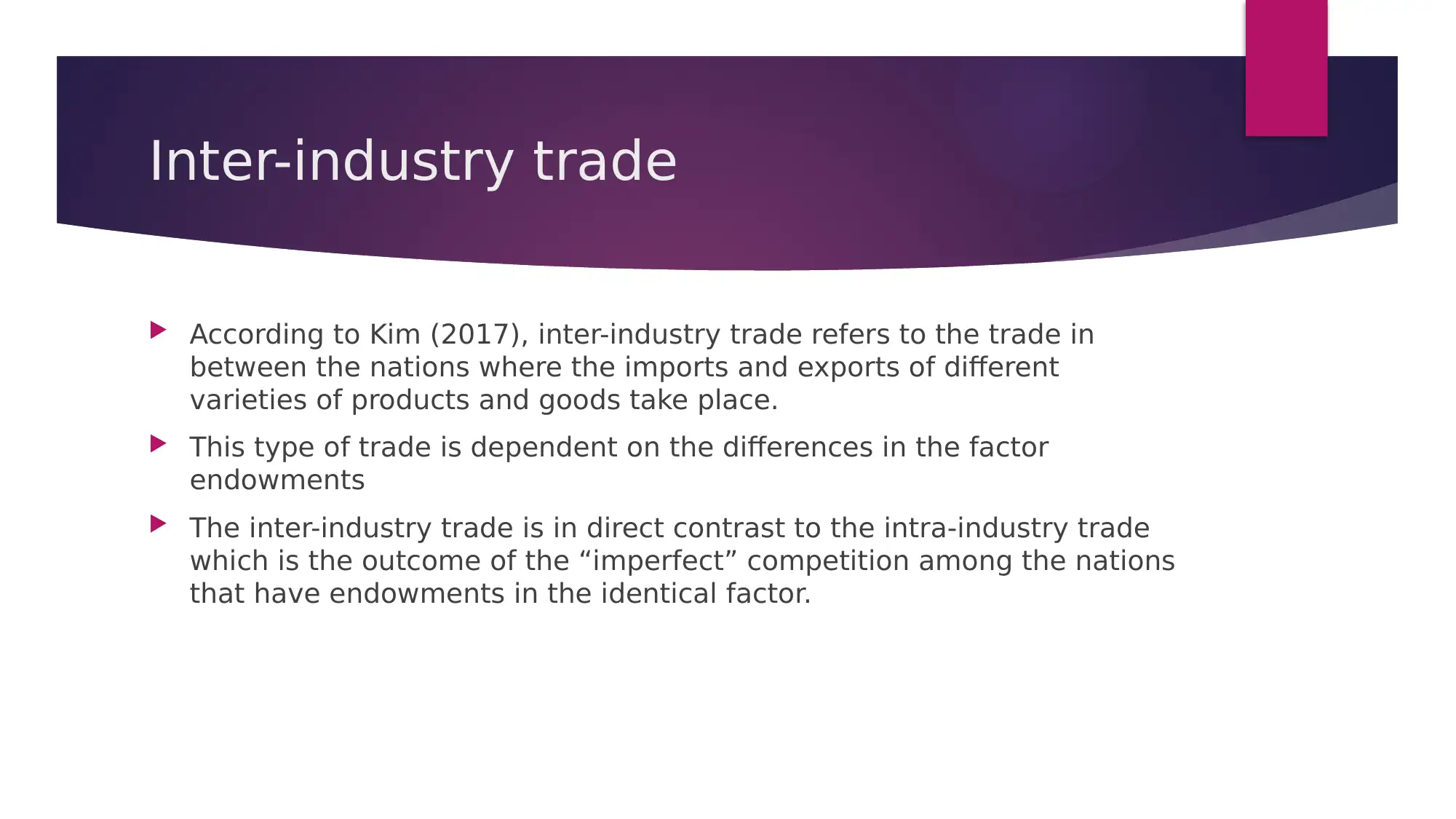
Inter-industry trade
According to Kim (2017), inter-industry trade refers to the trade in
between the nations where the imports and exports of different
varieties of products and goods take place.
This type of trade is dependent on the differences in the factor
endowments
The inter-industry trade is in direct contrast to the intra-industry trade
which is the outcome of the “imperfect” competition among the nations
that have endowments in the identical factor.
According to Kim (2017), inter-industry trade refers to the trade in
between the nations where the imports and exports of different
varieties of products and goods take place.
This type of trade is dependent on the differences in the factor
endowments
The inter-industry trade is in direct contrast to the intra-industry trade
which is the outcome of the “imperfect” competition among the nations
that have endowments in the identical factor.
⊘ This is a preview!⊘
Do you want full access?
Subscribe today to unlock all pages.

Trusted by 1+ million students worldwide
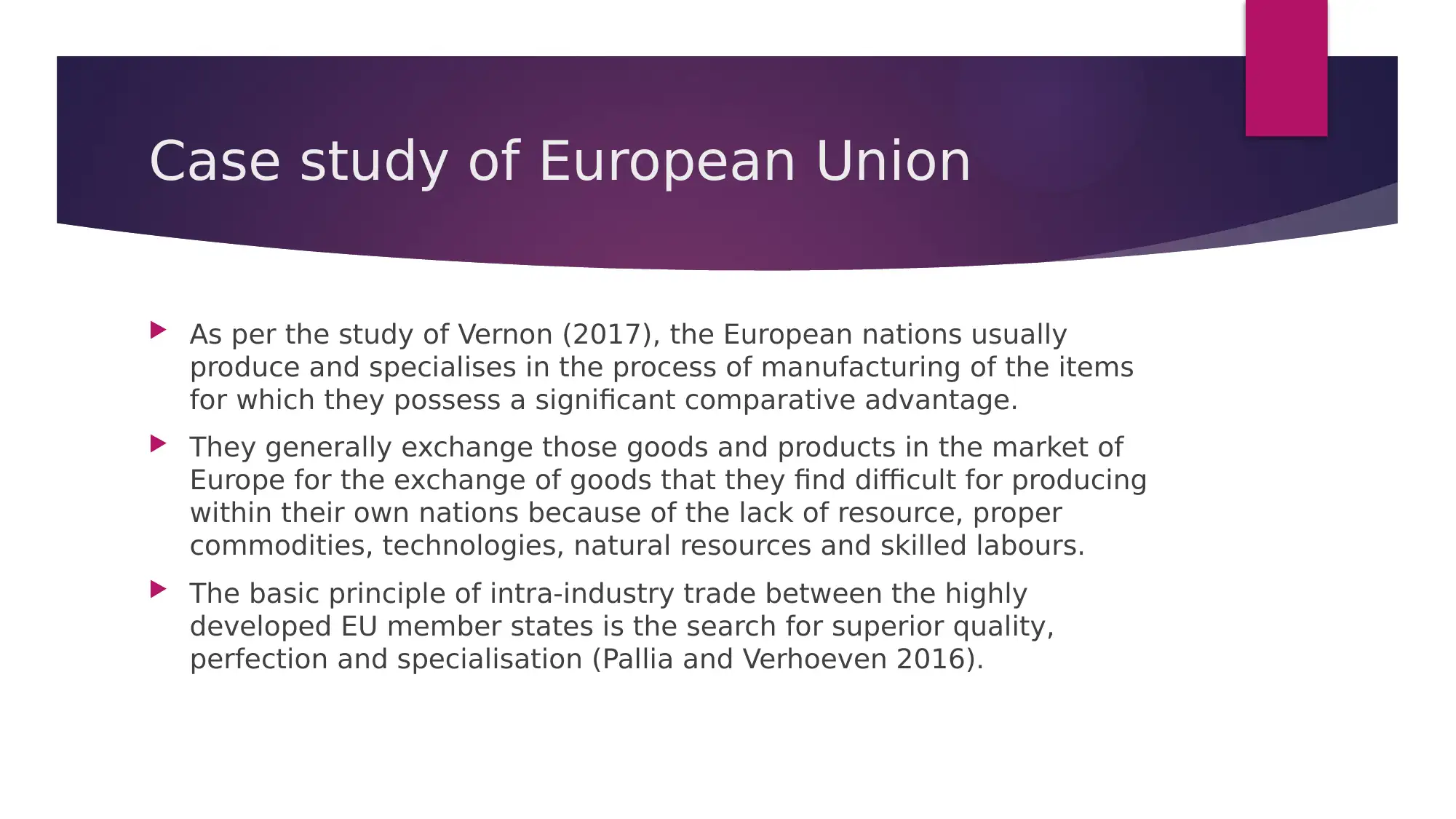
Case study of European Union
As per the study of Vernon (2017), the European nations usually
produce and specialises in the process of manufacturing of the items
for which they possess a significant comparative advantage.
They generally exchange those goods and products in the market of
Europe for the exchange of goods that they find difficult for producing
within their own nations because of the lack of resource, proper
commodities, technologies, natural resources and skilled labours.
The basic principle of intra-industry trade between the highly
developed EU member states is the search for superior quality,
perfection and specialisation (Pallia and Verhoeven 2016).
As per the study of Vernon (2017), the European nations usually
produce and specialises in the process of manufacturing of the items
for which they possess a significant comparative advantage.
They generally exchange those goods and products in the market of
Europe for the exchange of goods that they find difficult for producing
within their own nations because of the lack of resource, proper
commodities, technologies, natural resources and skilled labours.
The basic principle of intra-industry trade between the highly
developed EU member states is the search for superior quality,
perfection and specialisation (Pallia and Verhoeven 2016).
Paraphrase This Document
Need a fresh take? Get an instant paraphrase of this document with our AI Paraphraser
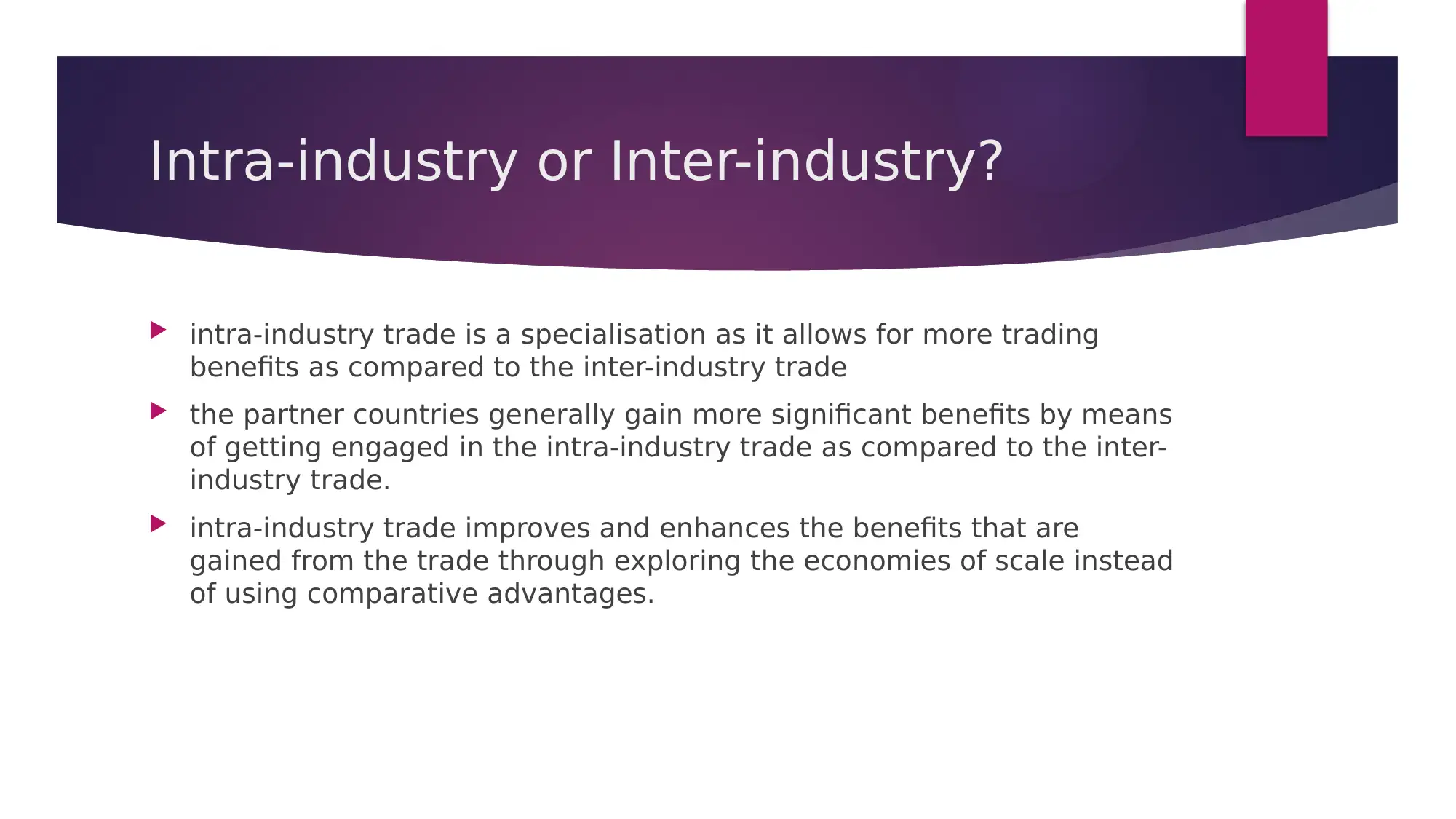
Intra-industry or Inter-industry?
intra-industry trade is a specialisation as it allows for more trading
benefits as compared to the inter-industry trade
the partner countries generally gain more significant benefits by means
of getting engaged in the intra-industry trade as compared to the inter-
industry trade.
intra-industry trade improves and enhances the benefits that are
gained from the trade through exploring the economies of scale instead
of using comparative advantages.
intra-industry trade is a specialisation as it allows for more trading
benefits as compared to the inter-industry trade
the partner countries generally gain more significant benefits by means
of getting engaged in the intra-industry trade as compared to the inter-
industry trade.
intra-industry trade improves and enhances the benefits that are
gained from the trade through exploring the economies of scale instead
of using comparative advantages.
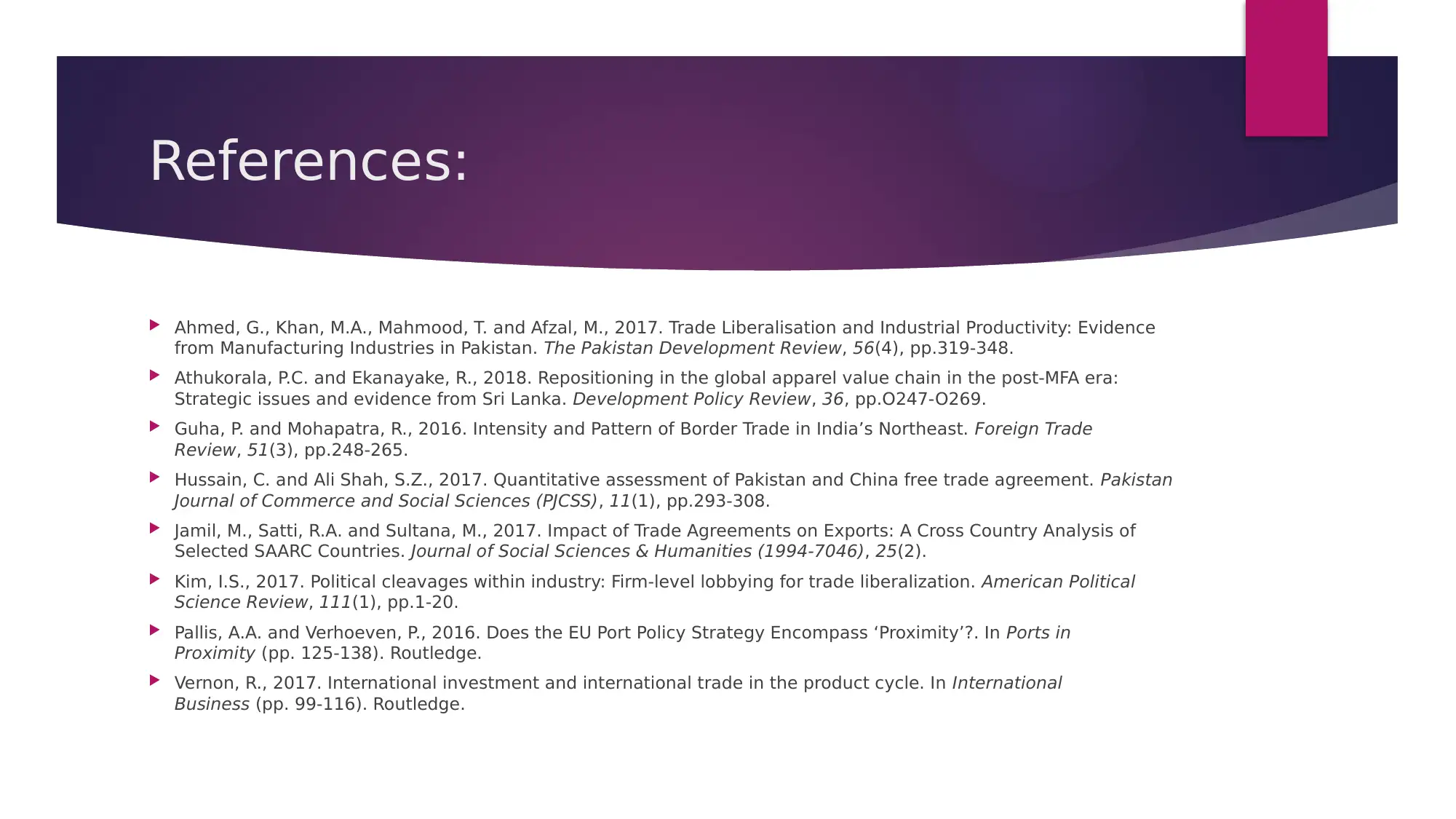
References:
Ahmed, G., Khan, M.A., Mahmood, T. and Afzal, M., 2017. Trade Liberalisation and Industrial Productivity: Evidence
from Manufacturing Industries in Pakistan. The Pakistan Development Review, 56(4), pp.319-348.
Athukorala, P.C. and Ekanayake, R., 2018. Repositioning in the global apparel value chain in the post‐MFA era:
Strategic issues and evidence from Sri Lanka. Development Policy Review, 36, pp.O247-O269.
Guha, P. and Mohapatra, R., 2016. Intensity and Pattern of Border Trade in India’s Northeast. Foreign Trade
Review, 51(3), pp.248-265.
Hussain, C. and Ali Shah, S.Z., 2017. Quantitative assessment of Pakistan and China free trade agreement. Pakistan
Journal of Commerce and Social Sciences (PJCSS), 11(1), pp.293-308.
Jamil, M., Satti, R.A. and Sultana, M., 2017. Impact of Trade Agreements on Exports: A Cross Country Analysis of
Selected SAARC Countries. Journal of Social Sciences & Humanities (1994-7046), 25(2).
Kim, I.S., 2017. Political cleavages within industry: Firm-level lobbying for trade liberalization. American Political
Science Review, 111(1), pp.1-20.
Pallis, A.A. and Verhoeven, P., 2016. Does the EU Port Policy Strategy Encompass ‘Proximity’?. In Ports in
Proximity (pp. 125-138). Routledge.
Vernon, R., 2017. International investment and international trade in the product cycle. In International
Business (pp. 99-116). Routledge.
Ahmed, G., Khan, M.A., Mahmood, T. and Afzal, M., 2017. Trade Liberalisation and Industrial Productivity: Evidence
from Manufacturing Industries in Pakistan. The Pakistan Development Review, 56(4), pp.319-348.
Athukorala, P.C. and Ekanayake, R., 2018. Repositioning in the global apparel value chain in the post‐MFA era:
Strategic issues and evidence from Sri Lanka. Development Policy Review, 36, pp.O247-O269.
Guha, P. and Mohapatra, R., 2016. Intensity and Pattern of Border Trade in India’s Northeast. Foreign Trade
Review, 51(3), pp.248-265.
Hussain, C. and Ali Shah, S.Z., 2017. Quantitative assessment of Pakistan and China free trade agreement. Pakistan
Journal of Commerce and Social Sciences (PJCSS), 11(1), pp.293-308.
Jamil, M., Satti, R.A. and Sultana, M., 2017. Impact of Trade Agreements on Exports: A Cross Country Analysis of
Selected SAARC Countries. Journal of Social Sciences & Humanities (1994-7046), 25(2).
Kim, I.S., 2017. Political cleavages within industry: Firm-level lobbying for trade liberalization. American Political
Science Review, 111(1), pp.1-20.
Pallis, A.A. and Verhoeven, P., 2016. Does the EU Port Policy Strategy Encompass ‘Proximity’?. In Ports in
Proximity (pp. 125-138). Routledge.
Vernon, R., 2017. International investment and international trade in the product cycle. In International
Business (pp. 99-116). Routledge.
⊘ This is a preview!⊘
Do you want full access?
Subscribe today to unlock all pages.

Trusted by 1+ million students worldwide

Thank You
1 out of 10
Related Documents
Your All-in-One AI-Powered Toolkit for Academic Success.
+13062052269
info@desklib.com
Available 24*7 on WhatsApp / Email
![[object Object]](/_next/static/media/star-bottom.7253800d.svg)
Unlock your academic potential
Copyright © 2020–2025 A2Z Services. All Rights Reserved. Developed and managed by ZUCOL.





